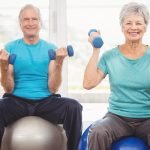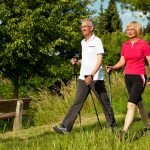Do you have a job that requires you to be on your feet for most of the day? If so, it can probably get really tiring. On the bright side, however, you’ve probably been somewhat relieved when hearing all of the news stories about how sitting at a desk for hours can ultimately kill you. But don’t start to feel too pleased just yet. There is now research that suggests standing too much at work might be just as bad for your health as sitting too much.
The study, which took place at the Institute for Work and Health in Toronto, Canada, found that people employed in occupations that require mostly standing for hours may have as much as twice the risk of developing heart disease as their peers who are sitting in a chair for a similar length of time.1 Smith, Peter; et al. “The Relationship Between Occupational Standing and Sitting and Incident Heart Disease Over a 12-Year Period in Ontario, Canada.” American Journal of Epidemiology. 27 September 2017. Accessed 2 October 2017. http://academic.oup.com/aje/article/doi/10.1093/aje/kwx298/4081581/The-Relationship-Between-Occupational-Standing-and. These results are based on the responses of 7,320 employed men and women participating in the Canadian Community Health Survey.
None of the subjects had been diagnosed with cardiovascular disease prior to the start of the investigation. However, during the 12 years in which they were tracked, quite a few developed this condition. And those who were employed as cooks, cashiers, retail sales clerks, bank tellers, and other such jobs that involve standing on one’s feet for hours were shown to be twice as likely to develop heart disease as those who earned their living through occupations in which they were mainly seated. What’s more, the results remained the same even after the researchers controlled for a variety of influences including age, body mass index, education level, marital status, and health issues such as hypertension and diabetes.
Are you confused yet? Feeling like you’re cursed if you sit and cursed if you stand? Well, it’s actually explainable, and there are solutions.
We already know plenty about the damage that is done by sitting all day long at work. A 2011 study at the University of Queensland in Australia found that too much sitting is associated with diabetes and heart disease,2 Healy, Genevieve N.; et al. “Sedentary time and cardio-metabolic biomarkers US adults: NHANES 2003-06.” European Heart Journal. 11 January 2011. Accessed 2 October 2017. http://academic.oup.com/eurheartj/article/32/5/590/426997/Sedentary-time-and-cardio-metabolic-biomarkers-in?searchresult=1. and another 2011 study at the University of Calgary in Canada showed that abundant sitting is linked with cancer.3 Friedenreich, Christine. “Observational and Experimental Evidence for the Role of Physical Activity in Cancer Control.” American Institute for Cancer Research. 4 November 2011. Accessed 2 October 2017. http://www.aicr.org/assets/docs/pdf/research/rescon2011/Friedenrich-2011-Approved.pdf. So why would it be that standing—which burns approximately 50 more calories an hour and seems intuitively at least a little better than sitting—would be worse for the body, at least from a cardiac perspective?
The problem might be a result of gravity. When you stand for a long period, blood tends to eventually pool in the legs, causing bulging varicose veins. In the circulatory system, this pooling blood must travel back to the heart, placing greater pressure on the veins along the way. That can take a toll over time, weakening the walls of the veins, damaging their valves, and contributing to heart disease.
There are far fewer forms of employment that require people to stand all day than sit. In the current investigation, less than 10 percent of the volunteers worked in standing occupations, versus approximately 37 percent who mostly were seated on the job. The remainder of respondents had positions that alternated to some extent between standing, sitting, and walking.
If you are among those who spend your work hours on your feet, you will be best off from a health perspective if you try to incorporate at least some sitting and walking into your occupational standing. You can request a standing desk with a high seat if you’re behind a counter in order to take the weight off your legs while you appear to be standing. Another idea is to try to work out a schedule with your colleagues in which, at least during slower periods, you are taking shifts standing and sitting to do your work.
And, just as we’ve recommended to your friends who spend their work time in chairs, don’t forget to take walks every hour or so. Walking a couple of laps around your place of business, even for two minutes can make a difference. It pumps blood against gravity and moves it out of your lower extremities. Try to make up for your lack of movement the rest of the day as much as you can. Before work, during your lunch break, and after the work day is done are all good opportunities to get yourself moving and undo some of the damage. Go for a walk or bike ride to get in some aerobic exercise, add a little strength training to keep your muscles fit, and don’t forget a flexibility routine to stretch yourself out after a long day on your feet.
References
| ↑1 | Smith, Peter; et al. “The Relationship Between Occupational Standing and Sitting and Incident Heart Disease Over a 12-Year Period in Ontario, Canada.” American Journal of Epidemiology. 27 September 2017. Accessed 2 October 2017. http://academic.oup.com/aje/article/doi/10.1093/aje/kwx298/4081581/The-Relationship-Between-Occupational-Standing-and. |
|---|---|
| ↑2 | Healy, Genevieve N.; et al. “Sedentary time and cardio-metabolic biomarkers US adults: NHANES 2003-06.” European Heart Journal. 11 January 2011. Accessed 2 October 2017. http://academic.oup.com/eurheartj/article/32/5/590/426997/Sedentary-time-and-cardio-metabolic-biomarkers-in?searchresult=1. |
| ↑3 | Friedenreich, Christine. “Observational and Experimental Evidence for the Role of Physical Activity in Cancer Control.” American Institute for Cancer Research. 4 November 2011. Accessed 2 October 2017. http://www.aicr.org/assets/docs/pdf/research/rescon2011/Friedenrich-2011-Approved.pdf. |












The question should are
The question should are people who stand all day at work at the same risk of poor health as those who sit down for more than 8 hrs per day.
The answer? It depends, on whether they are following healthy diet and lifestyle since this is the more critical indicator of longevity.
I am 72, stand for up to 16hrs per day at my computer and am super fit and perfect biomarkers. No leg and vein problems but I do take ‘walk breaks’ and walk fast. If I want to rest I lay down.
Narrow studies are useless without including all the markers for good health.
Typical of researchers to reduce it to one aspect.
It seems to me that all the
It seems to me that all the standing jobs mentioned are also very stressful. While the study apparently accounted for hypertension, some stressed-out people don’t quite fall into that category. The stress can still impact their hearts. It makes common sense to combine standing, sitting and walking throughout the day, a great piece of advice the study ultimately discovered.
HAD TWO STENTS PUT IN AND ON
HAD TWO STENTS PUT IN AND ON BLOOD THINNERS WANT OFF AND WANT THE BEST NATURAL THINNER NUTRIENT CAN GET